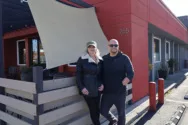
Home » Farmers help fuel fight against hunger
Fields to families
Farmers help fuel fight against hunger

Debbie Maier sorts Washington-grown apples at Second Harvest's Pasco warehouse. Volunteers, farmers and processors who donate their time and product are the lifeblood of Second Harvest.
Courtesy Second HarvestJune 14, 2024

Eric Williams
It’s the first harvest that makes the second harvest possible.
At Second Harvest, we are humbly fighting hunger across a 26-county region spanning Central Washington, Eastern Washington and North Idaho. Our mission is made possible by the hard work and dedication of the good people in agriculture and the food industry, who generously donate 90% – yes, 90% – of the 35 million pounds of food we distribute each year. For context, 35 million pounds is more than 17 semitruck loads a week and equates to more than 29 million meals over a year’s time.
We are grateful for the opportunity to put this generosity into action, serving people facing hunger through an amazing network of local pantries. Of course, the numbers vary a bit each year, but half of the food we bring in comes from farmers, ranchers, manufacturers and processors. A large portion of that comes from the swath of the state going from northeastern Okanogan County and south to the Columbia River. Not surprisingly, Benton, Franklin, Grant and Yakima counties are substantial contributors to our ability to get food to those who need it most.
Our valued partners, like AgriNorthwest, have been providing potatoes and onions to Second Harvest for over a decade. As Kyle Barclay from AgriNorthwest explains, “Our culture is service oriented. We see where needs are, and we try to fill them as best we can.”
In Washington, a state known for its bountiful agriculture, Second Harvest is fortunate to receive and distribute a wide variety of fresh, local fruits and vegetables to people facing hunger. “No one person, no one company will do it alone. It’s everybody doing their part. We can provide a potato or an onion, but somebody else is going to provide a cherry or an apple,” Barclay said.
Why they donate
Farmers and growers donate food for various reasons, whether it’s due to excess product, crops that don’t fit the retail market or the desire to make an impact. Every donation helps fuel our mission. As Barclay puts it, “You just feel like you’re helping somebody. You don’t know who they are or what all their needs are – you’re just able to give back somewhere. Donating to Second Harvest provides an easy, effective way to do that.”
Other notable food sources are wholesalers and what we call Grocery Rescue, which is food donated by retailers. A small amount also comes from government agencies. During the Covid-19 pandemic, we received a surge of food from government sources, we’re now back to a norm of about 5%.
The food we do purchase mostly falls into two categories. One is Bite2Go: weekend food supplies for local schoolchildren in need. The other is bulk purchases of staples, such as dried beans or rice. Our volunteers help us repackage those into family-sized portions, ensuring we can stretch our resources to help as many people as possible.
Army of volunteers
Our work wouldn’t be possible without the dedicated army of volunteers who show unwavering loyalty to their communities. They work tirelessly to distribute food fairly, ensuring the most vulnerable are not harmed by hunger. We are deeply appreciative of everyone who pitches in to help feed their hungry neighbors. We simply couldn’t come close to distributing 29 million meals across the region without them.

Kyle Barclay, left, of AgriNorthwest, a longtime food donor, and Mike Thomsen, who sources food for Second Harvest, check out the crop.
| Courtesy Second HarvestA food bank for food banks
You can think of Second Harvest as a food bank for food banks. We do not directly serve the public from either our Pasco or Spokane facilities; rather, we procure large quantities of food and distribute it to your community food banks and meal sites. We work with some 250 partner organizations across our 51,000-square-mile service territory, including 26 in Benton and Franklin counties. The vast majority of those are staffed by volunteers and some have maybe one or two paid employees.
Food insecurity
Local people need the food Second Harvest provides. We’re part of Feeding America, which crunches large volumes of data to produce what’s called Map the Meal Gap. The 2022 numbers were recently released and show that across the 21 Central and Eastern Washington counties we serve, 13.7% of the population, or 1 in 7, is food insecure. Worse, 19.5% of children, or 1 in 5, faces hunger.
We are determined to drive those numbers down, and we remind ourselves every day that seeds in the ground are the place to start.
How to help
From volunteering to donating food or funds, there are many ways you can help end hunger in our community. Contact [email protected] or 509-535-0787 to learn more about how you can get involved today.
Eric Williams joined Second Harvest in August 2020 during the pandemic. His passions include agriculture and a vibrant rural America.
Focus Magazine Local News Charitable Giving & Nonprofits Agriculture + Viticulture
KEYWORDS June 2024
Related Articles





